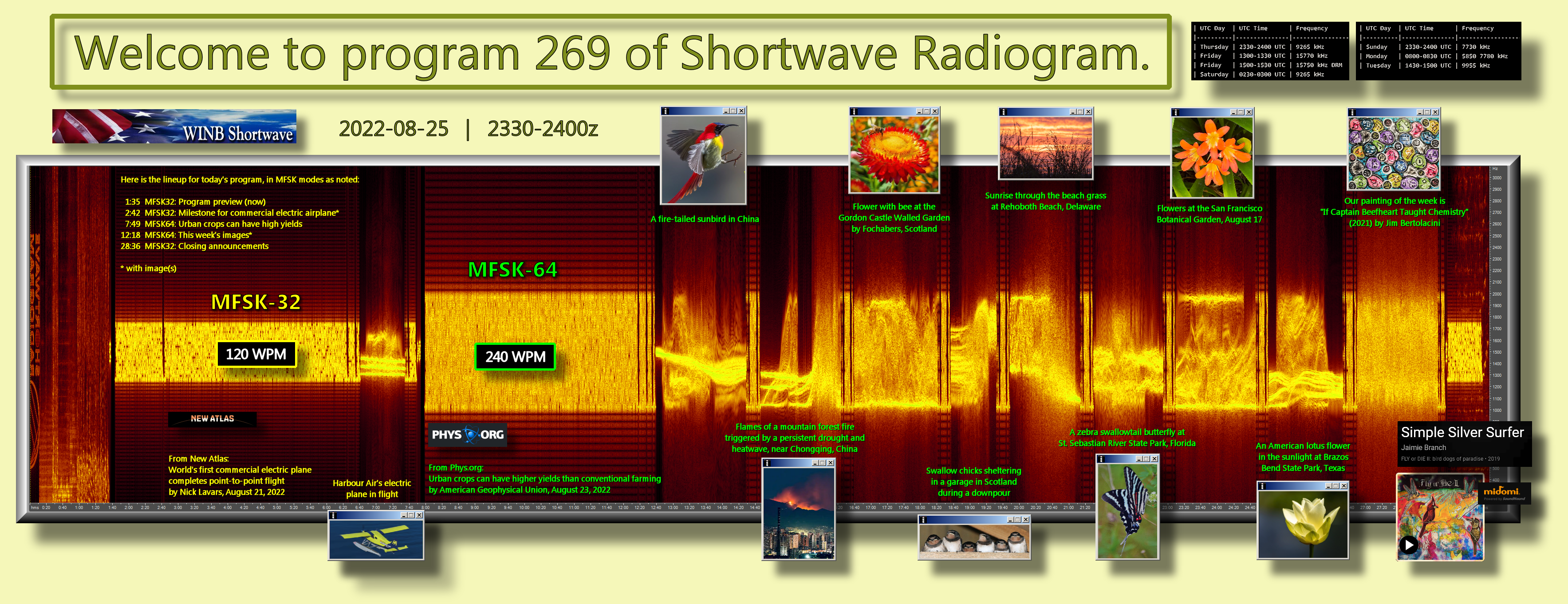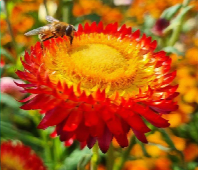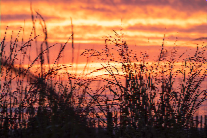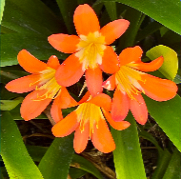http://www.rhci-online.net/radiogram/radiogram.htm

http://www.rhci-online.net/radiogram/radiogram.htm

RSID: <<2022-08-25T23:31Z MFSK-32 @ 9265000+1500>>
Welcome to program 269 of Shortwave Radiogram.
I'm Kim Andrew Elliott in Arlington, Virginia USA.
Here is the lineup for today's program, in MFSK modes as noted:
1:35 MFSK32: Program preview (now)
2:42 MFSK32: Milestone for commercial electric airplane*
7:49 MFSK64: Urban crops can have high yields
12:18 MFSK64: This week's images*
28:36 MFSK32: Closing announcements
* with image(s)
Please send reception reports to radiogram@verizon.net
And visit http://swradiogram.net
We're on Twitter now: @SWRadiogram
From New Atlas:
World's first commercial electric plane completes point-to-point
flight
by Nick Lavars
August 21, 2022
An aviation company at the cutting edge of electrified air travel
has taken a significant step forward, completing a
first-of-a-kind test flight using a retrofitted seaplane. Harbour
Air's De Havilland Beaver completed a short hop from the Canadian
mainland to Vancouver Island using its all-electric drivetrain,
demonstrating the viability of its cleaner approach to short-haul
flights.
Harbour Air is the largest seaplane airline in North America and
claims to transport around half a million passengers across
30,000 commercial flights each year. In 2019, it pledged to
become the world's first all-electric airline, a bold vision that
involves retrofitting its fleet of existing six-seater seaplanes
with electric propulsion systems.
These systems come via a partnership with electric motor company
MagniX, which is making important advances with its high-power
electric motors and has partnered with other ambitious companies
in the aviation space.
In December of 2019, the modified De Havilland Beaver took off to
complete the first successful flight of an all-electric
commercial aircraft, a brief jaunt above the Fraser River at
Harbour Air's terminal in Richmond, British Columbia. The company
has since continued this testing program with an eye to
certifying and approving the aircraft with the US Federal
Aviation Administration (FAA) and Transport Canada.
Last week, on August 17, the company's electric aircraft
completed its first point-to-point test flight, in what might
resemble a future commercial service. The plane took off at 8:12
am from its Fraser River Terminal and landed at Patricia Bay on
Vancouver Island 24 minutes later, completing a 45-mile (72-km)
journey purely on electricity, with ample power reportedly
leftover.
"I am excited to report that this historic flight on the ePlane
went exactly as planned" said Kory Paul, Harbour Air’s Vice
President of Flight Operations and one of the company’s test
Pilots. "Our team as well as the team at magniX and Transport
Canada are always closely monitoring the aircraft’s performance
and today’s flight further proved the safety and reliability of
what we have built."
Source: Harbour Air
https://newatlas.com/aircraft/worlds-first-commercial-electric-plane-harbour-air/
Image: Harbour Air's electric plane in flight.
Sending Pic:210x86C;

Shortwave Radiogram now changes to MFSK64 ...
RSID: <<2022-08-25T23:37Z
MFSK-32 @
9265000+1500>>
This is Shortwave Radiogram in MFSK64
Please send your reception report to
radiogram@verizon.net
From Phys.org:
Urban crops can have higher yields than conventional farming
by American Geophysical Union
August 23, 2022
As urban populations boom, urban agriculture is increasingly
looked to as a local food source and a way to help combat
inequitable food access. But little is known about how productive
urban agriculture is compared to conventional, rural farming. A
new study digs in, finding urban gardeners and hydroponics can
meet and sometimes exceed the yields of rural farms.
"Despite its growing popularity, there's still quite a lot we
don't know about urban agriculture, like whether the yields are
similar to conventional agriculture, or even what crops are
commonly grown," says Florian Payen, an environmental scientist
at Lancaster University and lead author of the study, published
today in AGU's journal Earth's Future.
The new study compiles studies on urban agriculture from 53
countries to find out which crops grow well in cities, what
growing methods are most effective, and what spaces can be
utilized for growing. The researchers find that urban yields for
some crops, like cucumbers, tubers and lettuces, are two to four
times higher than conventional farming. Many other urban crops
studied are produced at similar or higher rates than in rural
settings. Cost efficiency remains an open but important question.
Most studies on urban agriculture have focused on green spaces,
such as private and community gardens, parks and field growing
operations. Payen's work includes "gray" spaces—places in cities
that are already built but could be used for growing, such as
rooftops and building facades. In both green and gray spaces, the
study examines a suite of crops grown in soils versus
hydroponics, horizontal versus vertical farming, and natural
versus controlled conditions.
"Surprisingly, there were few differences between overall yields
in indoor spaces and outdoor green spaces, but there were clear
differences in the suitability of crop types to different gray
spaces," Payen says. Certain crops like lettuces, kale and
broccoli are more naturally suited to be grown vertically in
indoor spaces than others. "You can't exactly stack up apple
trees in a five- or ten-layer high growth chamber," he says,
"though we did find one study that managed to grow wheat stacked
up like that."
Other crops, like watery vegetables (e.g., tomatoes) and leafy
greens, performed well in hydroponic environments. And crops
grown in fully controlled environments can be grown throughout
the year, allowing harvests to happen more times per year than in
open-air environments, which leads to higher annual yields. But
scientists will need to keep studying these systems to plan
cost-effective agriculture solutions.
The finding that urban agriculture can have similar or greater
yields to conventional agriculture "is exactly what we have been
waiting for in the urban agriculture research community," says
Erica Dorr, an environmental scientist at AgroParisTech who was
not involved in the study.
Growing data
Current estimates suggest that between 5% to 10% of legumes,
vegetables and tubers are grown in urban settings, and between
15% to 20% of global food is produced in cities. But getting a
handle on just how much food a city could produce for itself is
difficult without yield information like the data presented in
Payen's study. Payen and his collaborators are part of an
interdisciplinary team building evidence and understanding of the
value of urban growing for food security, health and the
environment.
"This is the first step," says Payen. Once scientists have
accurate estimates for urban crop yields, they can map out a
city's potential growing areas and calculate how much food could
be produced there. "That's the strength of this dataset, for
planners and policymakers to be able to see if it's worth it to
invest in rooftop gardens or greenhouses, for example, or if
hydroponic systems would be better." Future studies could also
use the data to estimate cities' potential to meet future food
demand and the likelihood that cities could be self-sufficient in
terms of food productions.
The lack of data has at times held up progress in implementing
effective, functional urban agriculture.
"As we engaged and talked with different stakeholders, such as
government agencies and local councils, we realized that the
absence of robust, comprehensive data on urban agricultural
yields was preventing them from going ahead and supporting the
development and implementation of urban food growing," Payen
says. "We need to understand realistically how much this form of
growing could contribute to food security to help make the
business case for it."
Scaling up is also a key point for Dorr. "What percent of a
city's vegetable and fruit consumption can urban agriculture
provide? Studies have already estimated this, but with
lower-quality yield data than this new study provides. But, we
need to consider not just how much food could be produced, but at
what environmental cost."
It remains to be seen whether growing food in cities has a
smaller or larger overall carbon footprint than conventional
agriculture; the answer likely varies. Researchers are also
studying how foods grown in cities might be impacted by
pollution. And some crops included in the study's literature
review lacked the numbers to be included in statistical analyses,
pointing to a need for more research on urban crops like fruits
and cereals.
https://phys.org/news/2022-08-urban-crops-higher-yields-conventional.html
See also:
https://phys.org/news/2022-08-effectively-vegetables-grown-urban-soil.html
This is Shortwave Radiogram in MFSK64
Please send your reception report to
radiogram@verizon.net
This week's images ...
A fire-tailed sunbird in China.
https://bit.ly/3PIbIwd ...
Sending Pic:187x196C;

Flames of a mountain forest fire triggered by a persistent
drought and heatwave, near Chongqing, China.
https://bit.ly/3QQB7oF ...
Sending Pic:159x204C;

Flower with bee at the Gordon Castle Walled Garden by Fochabers,
Scotland. https://bbc.in/3AoWlmr ...
Sending Pic:198x170C;

Swallow chicks sheltering in a garage in Scotland during a
downpour. https://bbc.in/3AoWlmr ...
Sending Pic:247x75C;

Sunrise through the beach grass at Rehoboth Beach, Delaware.
https://bit.ly/3CvJB05 ...
Sending Pic:207x138C;

A zebra swallowtail butterfly at St. Sebastian River State Park,
Florida. https://bit.ly/3wtea2Q ...
Sending Pic:133x212C;

Flowers at the San Francisco Botanical Garden, August 17.
https://bit.ly/3cnWDlS ...
Sending Pic:181x179C;

An American lotus flower in the sunlight at Brazos Bend State
Park, Texas. https://bit.ly/3PMSkht ...
Sending Pic:200x150C;

Our painting of the week is "If Captain Beefheart Taught
Chemistry" (2021) by Jim Bertolacini.
https://bit.ly/3dU7kNg ...
Sending Pic:203x161C;

Shortwave Radiogram returns to MFSK32 ...
RSID: <<2022-08-25T23:58Z
MFSK-32 @
9265000+1500>>
This is Shortwave Radiogram in MFSK32 ...
Shortwave Radiogram is transmitted
by:
WRMI, Radio Miami International, wrmi.net
and
WINB Shortwave, winb.com
Please send reception reports to
radiogram@verizon.net
And visit http://swradiogram.net
Twitter:
@SWRadiogram or twitter.com/swradiogram
I'm Kim Elliott. Please join us for the next Shortwave
Radiogram.
|
Closing music SWRG#269: https://www.midomi.com/Track?trackID=100431925785727799&song=simple-silver-surfer
https://en.wikipedia.org/wiki/Jaimie_Branch
|
http://www.rhci-online.net/radiogram/radiogram.htm
|
QTH: |
D-06193 Petersberg (Germany/Germania) |
|
|
Ant.: |
Dipol for 40m-Band & Boomerang Antenna 11m-Band |
|
|
RX for RF: |
FRG-100B + IF-mixer & ICOM IC-R75 + IF-mixer |
|
|
Software IF: |
con STUDIO1 - Software italiano per SDR [S-AM-USB/LSB] + beta 11 Version 2.80 (August 21, 2018) - for scheduled IF-recording |
|
|
Software AF: |
Fldigi-4.0.18 + flmsg-4.0.7 images-fldigifiles on homedrive.lnk |
|
|
OS: |
German XP-SP3 with support for asian languages |
German W7 32bit + 64bit |
|
PC: |
MEDION Titanium 8008 (since 2003) [ P4 - 2,6 GHz] |
MSI-CR70-2MP345W7 (since2014) [i5 -P3560 ( 2 x 2,6GHz) ] |
http://wiki.radioreference.com/index.php/Decoding_the_SW_Radiogram_Broadcasts
https://www.qsl.net/ve7vv/Files/Digital%20Modes.pdf
RSID: <<2022-08-28T01:30Z
MFSK-64 @
9925000+1500>>
Joe Walsh was born Joseph Fidler Walsh, November 20, 1947 ...
Sending Pic:253x179;

joewalsh.com
Please report your decode to
themightykbc@gmail.com
https://en.wikipedia.org/wiki/Joe_Walsh
https://en.wikipedia.org/wiki/Joe_Walsh#Amateur_radio
https://de.wikipedia.org/wiki/Datei:Wb6acu.png
(Ham Nation 144: Joe Walsh(WB6ACU) Enters Ham Radio)

RSID: <<2022-08-25T02:46Z
MFSK-64 @
5850000+1500>>
This Is A Music Show #180
25 August 2022
0200-0300UTC Thursday on 5850 kHz
via WRMI, Okeechobee USA
***ALSO***
TIAnExpressMS w/ Radio Northern Europe International
via Channel 292 in Germany, mainly on 6070 kHz
Broadcast various dates/times/freqs Check the schedule here:
https://www channel292 de/
https://rnei org/
----------------------------------------
PLAYLIST
George Abdo - Dance Of The Sultans
-----
Brooklyn Bridge - Inside Out
Johnny Guitar Watson - Superman Lover
Nektar - Remember The Future
-----
1000 Homo DJs - Apathy
Rockers Revenge - Battle Cry
-----
Taeko Ohnuki - 幻惑
-----
THIS DATA w/ Bert Kaempfert - A Swingin' Safari
-----
Simple Minds - Someone Somewhere (In Summertime)
----------------------------------------
TIAMS Website:
https://thisisamusicshow com
Go here for show archives + official shop!
-----
Please send reception reports/comments:
thisisamusicshow@gmail com
Follow TIAMS on Twitter:
www twitter com/ThisIsAMusicSho/
------
Thanks for listening!
--YOUR HOST--
EOM
RSID: <<2022-08-25T02:46Z
MFSK-64 @
5850000+1500>>
Sending Pic:300x300Cp4;
